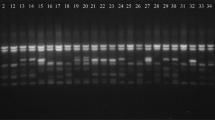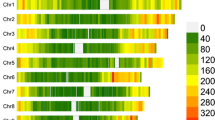Summary
Gossypium barbadense L. is a commercially important cotton species of tropical South American origin presently grownin many regions of the world. The species is morphologically diverse, consisting of a wide range of wild (or feral), commensal, landrace, and highly improvedcommercial forms. We performed allozyme analysis on 153 accessions representing the spectrum of G. barbadense diversityto ascertain the geographic origin of the species, its patterns of diffusion subsequent to domestication, and to reveal infraspecific relationships. Levels ofgenetic variation in G. barbadense are moderate. Of 59 loci scored, 24 were polymorphic, with a mean number of alleles perlocus of 1.69 and an average panmictic heterozygosity of 0.062. Principal component analysis revealed geographic clustering of accessions into six relativelydiscrete regions. Gene frequencies at many loci are significantly heterogeneous among these regions, with an average G STof 0.272. Northwestern South America contains the greatest genetic variability; we suggest that this region is the ancestral home of the species. The data indicate separate diffusion pathways from this region into Argentina-Paraguay and into eastern and northern South America east of the Andes. Caribbean Island and Central American forms appear to be derived from the latter. These diffusion pathways are in accordance with morphological evidence and historical record. In contrast to expectations based on geographic proximity, Pacific Island forms have their closest affinity to accessions from eastern South America. Advanced cultivated stocks seem largely derived from western Andean material, but also contain introgressed G. hirsutum germ plasm. Introgression was relatively high (22%–50% of accessions) in commercial stocks and in forms from Argentina-Paraguay and various Pacific Islands, but was conspicuously low or absent in material from Central America and the Caribbean, where commensal and commercial forms of both species are sympatric.
Similar content being viewed by others
References
Anonymous (1989) Cotton: Review of world situation. Bull Int Cotton Advis Comm 42:1–15
Balls WL (1912) The cotton plant in Egypt. Macmillan, London
Bourdon C (1986) Enzymatic polymorphism and genetic organization of two cotton tetraploid cultivated species, G. hirsutum and G. barbadense. Cotton Fibres Trop 41:191–210
Doebley JF (1989) Isozyme evidence and the evolution of crop plants. In: Soltis DE, Soltis PS (eds) Isozymes in plant biology. Dioscorides Press, Portland/OR (in press)
Feaster CV, Turcotte EL (1962) Genetic basis for the varietal improvement of Pima cottons. Crops Re, USDA-ARS 34-31, pp 1–15
Fryxell PA (1979) The natural history of the cotton tribe. Texas A&M University Press, College Station/TX
Harland SC (1936) Some notes on cotton in Columbia. Trop Agric/Trinidad 13:1–13
Harland SC (1939) Genetical studies in the genus Gossypium and their relationship to evolutionary and taxonomic problems. Proc 7th Int Genet Congr Edinburgh, pp 138–143
Hutchinson JB, Manning HL (1945) The Sea Island cottons. Emp J Exp Agric 13:80–92
Hutchinson JB, Silow RA, Stephens SG (1947) The Evolution of Gossypium. Oxford University Press, London
Kearney TH, Harrison GJ (1932) Pollen antagonism in cotton. J Agric Res 44:191–226
Kerr T (1960) The potentials of barbadense cottons. Proc 12th Ann Cotton Imp Conf, Memphis/TN, pp 57–60
Knight RL (1945) The theory and application of the backcross technique in cotton breeding. J Genet 47:76–86
Lewton FL (1920) The history of kidney cotton. J Wash Acad Sci 10:591–597
Mauer FM (1930) The cottons of Mexico, Guatemala, and Colombia. Bull Appl Bot Genet Pl Breed Suppl 47:543–553
Nei M (1987) Molecular evolutionary genetics. Columbia University Press, New York
Percival AE (1987) The National Collection of Gossypium germ plasm. Southern Coop Ser Bull 321:309–362
Sneath PHA, Sokal RR (1973) Numerical taxonomy. Freeman, San Francisco
Stephens SG (1946) The genetics of “corky”. I. The New World alleles and their possible role as an interspecific isolating mechanism. J Genet 47:150–161
Stephens G (1949) The cytogenetics of speciation in Gossypium. I. Selective elimination of the donor parent genotype in interspecific backcrosses. Genetics 34:627–637
Stephens SG (1963) Polynesian cottons. Ann Mo Bot Garden 50:1–22
Stephens SG (1974) The use of two polymorphic systems, nectary fringe hairs and corky alleles as indicators of phylogenetic relationships in New World cottons. Biotropica 6:194–201
Stephens SG (1975) Some observations on photoperiodism and the development of annual forms of domesticated cottons. Econ Bot 30:409–418
Stephens SG (1976) The origin of Sea Island cotton. Agric Hist 50:391–399
Stephens SG, Mosely ME (1974) Early domesticated cottons from archeological sites in central coastal Peru. Am Antiq 39:109–122
Stephens SG, Phillips LL (1972) The history and geographical distribution of a polymorphic system in New World cottons. Biotropica 4:49–60
Watt G (1907) The wild and cultivated cotton plants of the world. Longmans, Green, London
Weeden NF, Wendel JF (1989) Genetics of plant isozymes. In: Soltis DE, Soltis PS (eds) Isozymes in plant biology. Dioscorides Press, Portland/OR, (in press)
Wendel JF, Olson PD, Stewart JM (1989) Genetic diversity, introgression, and independent domestication of Old World cultivated cottons. Am J Bot (in press)
Wendel JF, Weeden NF (1989) Visualization and interpretation of plant isozymes. In: Soltis DE, Soltis PS (eds) Isozymes in plant biology. Dioscorides Press, Portland/OR (in press)
Author information
Authors and Affiliations
Additional information
Communicated by A.R. Hallauer
Rights and permissions
About this article
Cite this article
Percy, R.G., Wendel, J.F. Allozyme evidence for the origin and diversification of Gossypium barbadense L.. Theoret. Appl. Genetics 79, 529–542 (1990). https://doi.org/10.1007/BF00226164
Received:
Accepted:
Issue Date:
DOI: https://doi.org/10.1007/BF00226164




